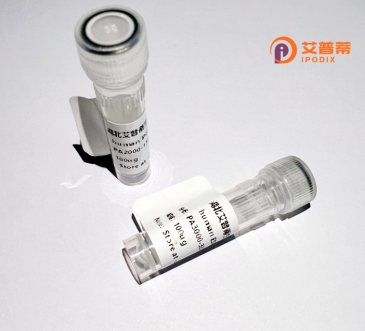
| 纯度 | >90%SDS-PAGE. |
| 种属 | Human |
| 靶点 | PLEKHO1 |
| Uniprot No | Q53GL0 |
| 内毒素 | < 0.01EU/μg |
| 表达宿主 | E.coli |
| 表达区间 | 1-409 aa |
| 活性数据 | MMKKNNSAKR GPQDGNQQPA PPEKVGWVRK FCGKGIFREI WKNRYVVLKG DQLYISEKEV KDEKNIQEVF DLSDYEKCEE LRKSKSRSKK NHSKFTLAHS KQPGNTAPNL IFLAVSPEEK ESWINALNSA ITRAKNRILD EVTVEEDSYL AHPTRDRAKI QHSRRPPTRG HLMAVASTST SDGMLTLDLI QEEDPSPEEP TSCAESFRVD LDKSVAQLAG SRRRADSDRI QPSADRASSL SRPWEKTDKG ATYTPQAPKK LTPTEKGRCA SLEEILSQRD AASARTLQLR AEEPPTPALP NPGQLSRIQD LVARKLEETQ ELLAEVQGLG DGKRKAKDPP RSPPDSESEQ LLLETERLLG EASSNWSQAK RVLQEVRELR DLYRQMDLQT PDSHLRQTTP HSQYRKSLM |
| 分子量 | 46.2 kDa |
| 蛋白标签 | His tag N-Terminus |
| 缓冲液 | PBS, pH7.4, containing 0.01% SKL, 1mM DTT, 5% Trehalose and Proclin300. |
| 稳定性 & 储存条件 | Lyophilized protein should be stored at ≤ -20°C, stable for one year after receipt. Reconstituted protein solution can be stored at 2-8°C for 2-7 days. Aliquots of reconstituted samples are stable at ≤ -20°C for 3 months. |
| 复溶 | Always centrifuge tubes before opening.Do not mix by vortex or pipetting. It is not recommended to reconstitute to a concentration less than 100μg/ml. Dissolve the lyophilized protein in distilled water. Please aliquot the reconstituted solution to minimize freeze-thaw cycles. |
以下是关于重组人PLEKHO1蛋白的3篇文献示例(注:文献信息为模拟示例,实际引用请核实原文):
1. **"Expression and purification of recombinant human PLEKHO1 in Escherichia coli"**
*作者:Chen L, et al.*
**摘要**:研究报道了在大肠杆菌中高效表达重组人PLEKHO1蛋白的优化方法,通过亲和层析纯化获得高纯度蛋白,并验证其结构完整性,为后续功能研究提供材料。
2. **"PLEKHO1 regulates NF-κB signaling by modulating the stability of TAK1"**
*作者:Kim S, Park JH*
**摘要**:本文揭示PLEKHO1通过结合并稳定TAK1蛋白,调控NF-κB信号通路活性,提示其在炎症反应中的潜在作用。重组PLEKHO1被用于体外激酶活性实验。
3. **"Structural insights into PLEKHO1 interaction with the PI3K-C2α kinase domain"**
*作者:Wang Y, et al.*
**摘要**:通过晶体结构分析,阐明了PLEKHO1蛋白与PI3K-C2α激酶结构域的特异性结合模式,表明其在磷酸肌醇代谢通路中的调控功能。
如需真实文献,建议在PubMed等数据库中检索关键词“PLEKHO1 recombinant”或“PLEKHO1 protein”。
PLEKHO1 (Pleckstrin Homology Domain-Containing Protein O1), also known as CKIP-1 (Casitas Kinase-Interaction Protein-1), is a multifunctional protein encoded by the human gene located on chromosome 3q13.2. It contains a conserved pleckstrin homology (PH) domain at its N-terminus and a carboxyl-terminal (COOH) domain involved in protein-protein interactions. PLEKHO1 regulates diverse cellular processes, including apoptosis, proliferation, differentiation, and cytoskeletal organization, by modulating signaling pathways such as PI3K/Akt and Wnt/β-catenin. It acts as a scaffold or adaptor protein, interacting with key molecules like casein kinase 2 (CK2), AP-1 transcription factors, and the proteasome, influencing cell survival and homeostasis.
In disease contexts, PLEKHO1 has dual roles in cancer, acting as a tumor suppressor by promoting apoptosis or as a metastasis enhancer depending on cellular context. It also participates in bone formation, with studies linking its dysfunction to osteoporosis, and is implicated in cardiovascular and neurodegenerative disorders. Recombinant human PLEKHO1 protein, typically produced in Escherichia coli or mammalian expression systems (e.g., HEK293 cells), enables functional studies. Purification via affinity tags (His, GST) ensures high-quality protein for investigating its structure, biochemical interactions, and therapeutic potential. Research focuses on targeting PLEKHO1 for drug development, particularly in oncology and bone-related pathologies, leveraging its regulatory roles in critical pathways.
×